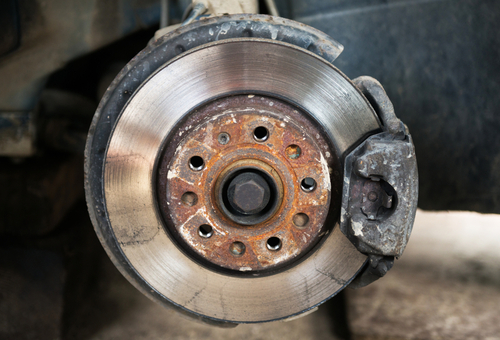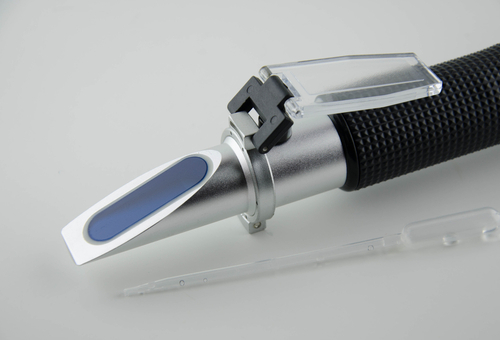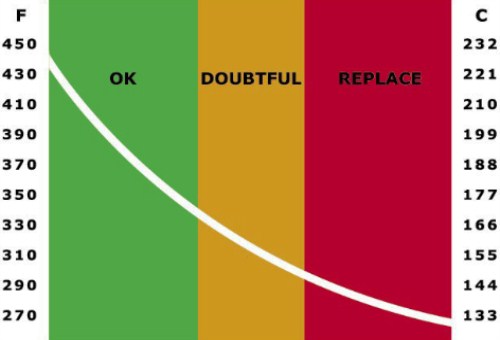
If you are newly qualified, you probably know everything there is to know about how modern automotive brake systems work, which is not a bad thing in today’s highly competitive job market. However, do you know as much about servicing modern brake systems as you do about how they work? Servicing modern brake systems goes a long way beyond merely checking brake fluid levels and adjusting parking brakes, and in this article, we will give you some pointers on what to look out for and how to avoid comebacks on brake jobs by paying proper attention to the quality of the brake fluid in the vehicles you work on. Let us start with saying that-
This article is not about brake fluid or brake fluid's chemical properties, except to say that a), brake fluid sucks water right out of the air, and b), that given enough time, water in brake fluid will permeate throughout the brake system.
You've probably heard that a million times before and you have very likely replaced wheel cylinders, callipers, and master cylinders as the result of corrosion caused by dissolved water in brake fluid, but have you always replaced the brake fluid as well?
You probably did, but if you did not, you should know that in cases where you did not replace the brake fluid, you did not resolve the customer’s concern. The problem is that customers do not always tell you the whole story. In many cases, a wheel cylinder or other component may have been leaking for a long time and as a result, the customer had been topping up the brake fluid reservoir regularly but customers do not always share these little details, and sometimes, we neglect to ask.
Thus, when you repaired the leak the brake fluid in the reservoir may have appeared to be fresh, so you may have assumed that all the brake fluid in the entire brake system was fresh, which it may not have been. This is an easy mistake to make, and many of us have made it especially when we were working under severe time constraints. Nonetheless, the effect of this mistake is that corrosion in the brake system is allowed to continue unabated- until the customer returns with a new brake fluid leak or worse, a brake master cylinder and/or ABS valve assembly that does not work as the result of corrosion in the brake system.
Of course, none of us has X-ray vision, and therefore, none of us can visually inspect the interiors of steel brake lines and other brake system components to assess the level of corrosion in a brake system, but we can do the next best thing, which is to-
Much has been said and written about how water in brake fluid affects braking efficiency, and we need not rehash all of it here. What we can say is that while manufacturers of brake fluid typically use a water content of 3.7% (in brake fluid) to establish the wet boiling points of their products, there are no objective standards anywhere in the world that establish or prescribe replacement intervals for brake fluid.
The closest thing we have to a standard is car manufacturers’ recommendation to replace brake fluid every two years, but from our perspective as technicians, this recommendation comes too close to a shotgun approach to prevent the possibility of comebacks on brake jobs. Therefore, we can do one of two things; we can replace the brake fluid on all vehicles we service as a matter of course, or, we can test the quality of the brake fluid on all the vehicles we service as a matter of course, and then replace the brake fluid if the procedure is warranted.
As a practical matter though, the first option could leave us open to the accusation that we are ripping off customers, and while the second option is a good idea in theory, it is sometimes difficult to justify the cost of replacing brake fluid to some customers. This is especially true from the customer’s perspective if the vehicle's brakes still work, and there are no visible brake fluid leaks present on the vehicle. The only thing we as technicians can do in such cases is to protect ourselves by testing the brake fluid and to educate the customer on the need to replace his brake fluid. However, since we need to be sure of our test results before we recommend a brake fluid replacement, let us take a look at-

The tool market has become flooded in recent years with all manner of gadgets and gizmos that are said (mainly) by their manufacturers to provide definitive (and near-instant) analyses of automotive fluids that include brake fluid, engine coolant, electrolyte from batteries, and even windscreen washer fluid. One such instrument is the refractometer shown above, and while we are not suggesting that none of these instruments is helpful, we are saying that some of these instruments work better than others do. Let us look at some of the pros of these instruments, but more specifically, some of the cons that could cause severe customer dissatisfaction and any number of comebacks, starting with-
Refractometers such as the one shown above use the refractive index of a liquid to measure its purity. Put in another way, this means that there is a direct correlation between the level of contamination in a liquid, and the way the contaminated liquid bends light when light travels through the liquid.
So if you are testing brake fluid with a refractometer that is designed to test brake fluid, you place a small sample of brake fluid into the instrument, and then look into a light source through an eyepiece to see a graduated scale that is divided into two colours, typically blue and white. In practice, the boundary between the blue and white parts of the scale represents zero so where the boundary crosses the scale would be the percentage of water in the brake fluid sample.
However, the accuracy of the reading depends entirely on the following two things-
Calibration
Depending on who made the instrument, you may need to calibrate it either with a known pure sample of the brake fluid or with a substance that is known to be uncontaminated, such as distilled water. Then you need to remove all traces of the liquid used for calibration purposes from the instrument to prevent contamination of the test sample before you can take a reading of an actual sample. Note that in most cases, you need to calibrate the instrument with brake fluid of the same DOT rating as the brake fluid you are going to test.
Temperature
Since the temperature of a liquid has a direct bearing on the density of that liquid, you need to let the temperature of the test sample adapt to the ambient temperature. Not doing this invariably results in wildly inaccurate readings because a marked temperature difference influences the way light bends when it passes through the brake fluid sample, which can either mask or accentuate the presence of contaminants in the test sample.
So would you use a refractometer to test brake fluid?
While there is no doubt that a refractometer can deliver highly accurate results, there are some downsides to these instruments. The first is that learning to use it properly takes lots of time and practice, and the second is that there is plenty of room to make mistakes while you are learning to use it.
This writer has seen brake fluid that was known to be free of water being condemned, and brake fluid that was known to contain 10% water by volume passing a refractometer test. In both tests, the same instrument was used by two different technicians to test DOT 4 brake fluid from sealed containers that were supplied by the same manufacturer. The brake fluid from one container was kept pure, while the brake fluid from another sealed container was deliberately contaminated with water. You can draw your own conclusions from this tale, but let us look at-
The operation of these testers is based on the conductivity of water, so by dipping the instrument’s probes into the brake fluid to be tested to measure the strength of a current that passes through water-contaminated brake fluid, the testing instrument can calculate the level of contamination. Once this value is “known”, some conductance testers are said to be able to extrapolate the wet boiling point of the brake fluid being tested from the measured/calculated water content.
While the idea behind these testers is sound, the execution often leaves much to be desired. In fact, in a recent test conducted by this writer three different conductance testers yielded three wildly different water contamination levels in the same brake fluid sample. This test was admittedly not conducted under controlled conditions, but the point is that unless test results can be replicated repeatedly, there is no guarantee that any individual result would be even close to accurate.
Thus, if you rely on a conductance tester alone, you might replace brake fluid that does not require replacing, or worse, you might believe your test result, and not replace brake fluid that is in dire need of replacement. Thus, if a brake fluid leak develops on a vehicle that had just had its brake fluid "checked" and passed as serviceable, it would be very difficult to explain to that customer why the problem was not detected in the first place.
So would you use a conductance tester to test brake fluid?
In the interest of fairness, it must be said that that there are two types of conductivity, or in some cases, capacitance testers available today. One type has two probes that are dipped into the sample, while with the other type, a few drops of the test sample is placed onto the instrument. This type of tester provides a digital readout, but the basic principles of operation remain the same.
In this writer’s experience, digital testers do not seem to be the more accurate of the two types, but then again, this writer has not tested every digital tester that is available on the market, so there might be some that are reasonably accurate most of the time. However, since factors like the brand, formulation, and DOT rating of brake fluid, as well as both the ambient temperature and the temperature of the test sample all influence the test, digital brake fluid testers should ideally be calibrated with a known good sample of the same brake fluid that is in the vehicle.
The only advice this writer can offer is to be aware of the fact that conductance testers are not created equal, and that you may get false, misleading, and/or wildly implausible test results with some of these testers, which brings us to the most consistently reliable test method of all, this method being-

Image source: https://www.albadiagnostics.com/article/35/brake_fluid_testing distributor guide
This graph shows the relationship between boiling points of brake fluid and levels of water contamination. The green block represents fresh brake fluid with no water content; the red block represents heavily contaminated brake fluid, while the orange block represents brake fluid that is partially contaminated. Note that "partially contaminated" refers to brake fluid that is contaminated with anything from trace amounts of water, to about 3.7% of water by volume.
The one major advantage that boiling point testers have over other types of testers is that they are not affected by environmental factors such as temperature differences, or by technical issues like faulty calibration. With a boiling point tester, you simply place a small sample of brake fluid in a supplied glass container and let the instruments' probe heat the sample to boiling point in the container.
The instrument then displays the actual boiling point of the sample, which correlates to the concentration of water in the brake fluid sample. Note though that different brake fluid brands, formulations, and DOT ratings have different wet boiling points, which means that you have to compare your obtained test result with data supplied by the manufacturer of the brake fluid being tested.
While this might seem like a hassle, the advantage of referring to published data sheets is the fact that you can compare an objective test result with reliable data, which means that with this method, you can arrive at definitive and repeatable assessments of the condition of any glycol-based brake fluid brand and/or DOT rating in any vehicle. Thus, no more guesswork, and no more comebacks on brake jobs as the result of unreliable test results, which brings us to-
While water contamination of brake fluid is the leading cause of many, if not most brake system failures, defects, or malfunctions, the level of dissolved copper in brake fluid should ideally be the most important consideration to keep in mind when you are assessing the quality of brake fluid in a vehicle.
When some additives in brake fluid become depleted mainly as the result of water contamination and oxidation, the acidity of the brake fluid increases exponentially, this then causes the copper that is used in brake lines to make them seamless, to corrode. While most of the dissolved copper is held in suspension, some of it starts to attach to metal surfaces in the brake system when the total copper concentration in the brake fluid exceeds a critical level.
In practice, the copper typically starts to accumulate in the ABS module first, where it can and often does, affect the operation of moving parts in the ABS module. The result is usually a progressive deterioration of ABS functionality, which if it is not corrected, usually results not only in the failure of the ABS brakes but also in the failure of ABS-dependent systems like traction and stability control systems, among others.
The most reliable way to test for copper contamination is to use dedicated test strips that change colour when they are dipped into the contaminated brake fluid, with the degree of colour change correlating directly to the level of copper contamination in the brake fluid sample. However, the best part of copper test strips is that they typically retain their changed colours for at least 3 weeks, which has you covered in case the customer complains that you either did or did not (as the case may be) replace the brake fluid in his vehicle.
It is perhaps worth noting that testing for copper contamination of brake fluid has become a standard requirement during brake inspections or repair jobs in major car repair franchise chains that include Firestone, Good Year, Monroe, Tire Kingdom, Jiffy Lube, Pep Boys, AAA and many others, some of which operate internationally. Testing for copper contamination is also required in terms of the AMRA EUICS standards, and in the state of California, copper testing is required to satisfy the requirements of that state’s Automotive Repair Act.
Based on the above, it should be clear that copper contamination of brake fluid is real, and that it has an equal, if not greater potential than water contamination to cause severe, if not always life-threatening damage to modern brake systems, which leaves us with this-
If we could draw one conclusion from the above, it would be this: brake inspections should no longer be something we do merely to complete inspection sheets or lists of items to be checked off and passed. At a minimum, brake inspections should now include the testing, monitoring, and maintaining the quality and purity of the brake fluid in our customer’s vehicles as a standard item to ensure the safe and efficient operation of the brake systems we work on.
It may be true that sudden and catastrophic brake system failures are relatively rare, but do we want to see repeated comebacks that may culminate in fatal brake system failure on a customer's vehicle, simply because we failed or neglected to test the brake fluid when we replaced the brake pads? We certainly do not, and we are fairly certain that neither you nor your customers want that.